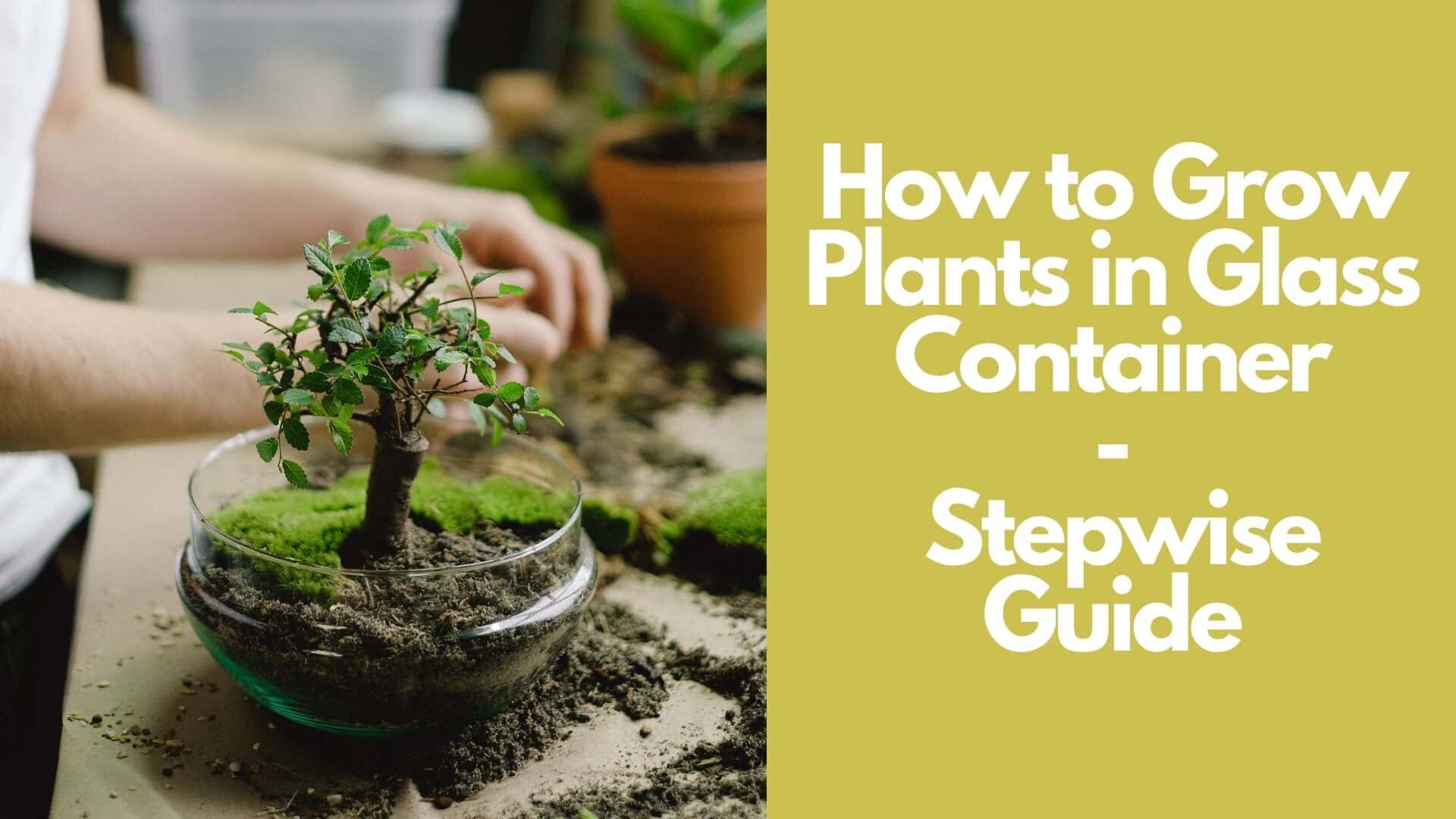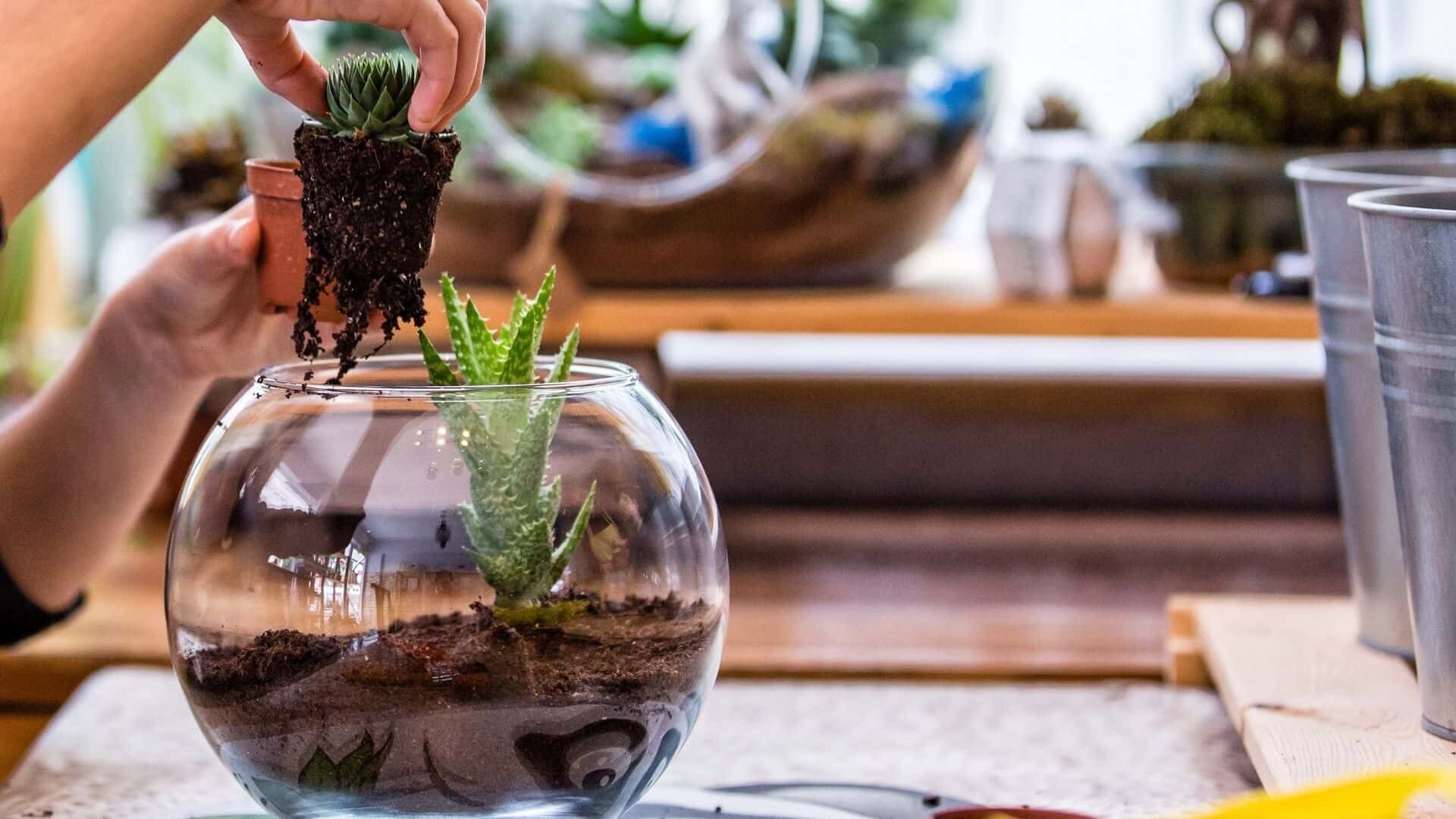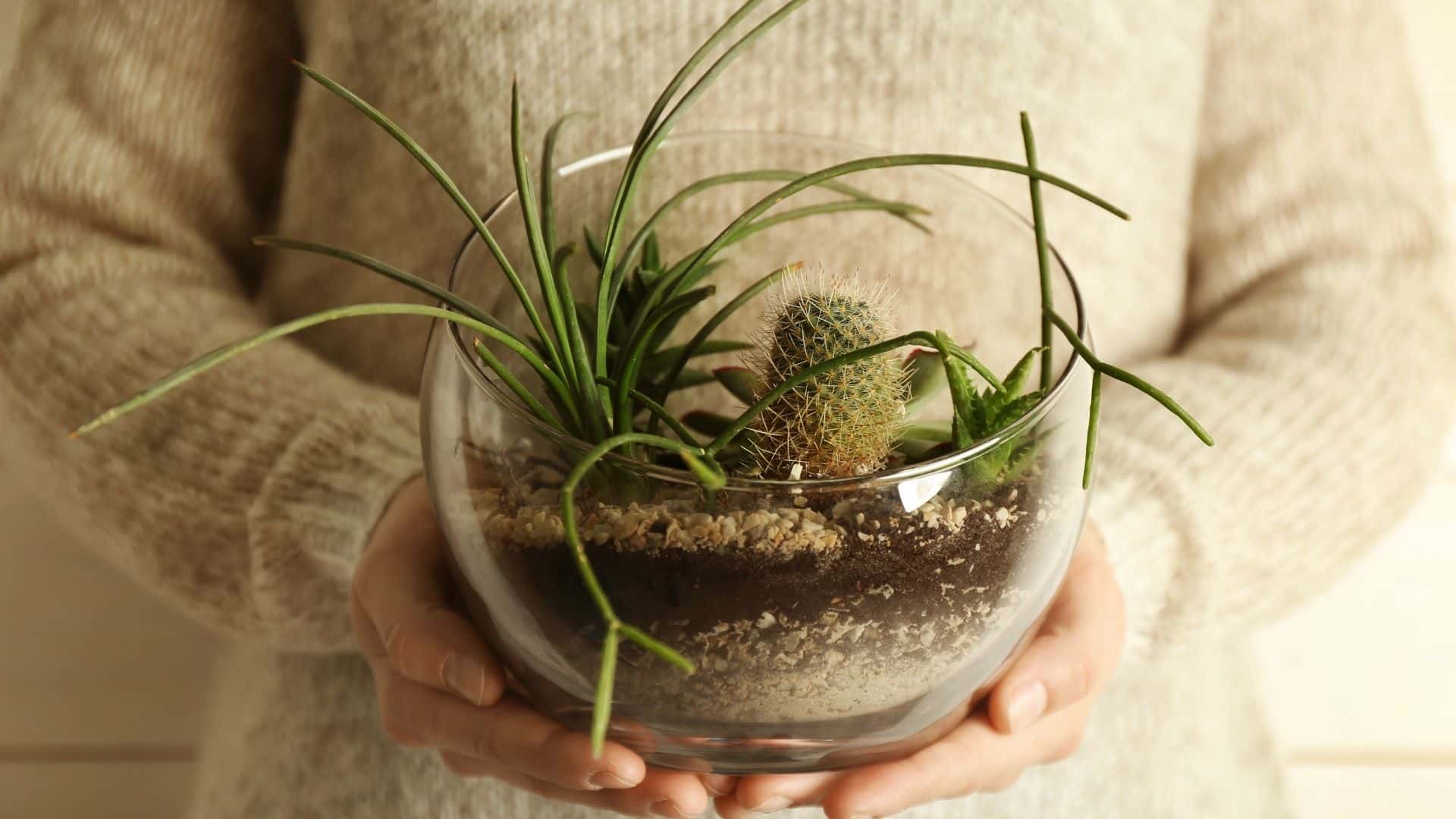Planting in glass containers is an easy method to grow many of your favorite plants even if you don’t have a lot of room for a garden outside. Plants in glass containers can be utilized as an alternative garden because they are simple to set up and maintain.
Glass container gardens, especially when adorned with vibrant foliage and a variety of textures, are a great way to add visual interest to a room. Whether you like the idea or the look of a glass container garden, there is no reason not to give it a try.
This allows you to grow a wide variety of plants that would otherwise be difficult to grow in the home. Gifts and presents are a wonderful opportunity to express yourself creatively, and making them is a good method to do so. By reading this guide, you will be able to know, How to Grow Plants in Glass Containers: 6 Steps Easy Guide.

Let’s start,
Don’t think that making a glass container to grow plants is difficult. It is really easy to make. You can make a beautiful glass container garden at your home.
How to make a glass container to grow plants?
You may grow a garden in any glass container, although closed ones are preferable for plants that need moist circumstances and open ones are best for those that prefer dry conditions. You can find the right glass container as your preference from garden centers and also your kitchen pantry.
You can make your own glass container gardens with just a few supplies.
What do you need to make it?
- Large glass container
- Warm water
- Soap
- Pebbles, gravels or Horticulture grit
- Charcoal
- Potting soil
- Plants
- Water
What are the steps to make it?
Here are 5 steps that you can follow when making the best glass container for your plants.
1. Choose the right glass container
Growing plants in a glass container begin with the selection of the right glass container. Usually, glass containers are clear. If you choose a colored container, you’ll need to select plants that can handle medium to low levels of light because clear glass containers allow the most sunshine to enter.
Planting is made easier by using containers with large enough apertures to fit your hand through. If not, you’ll have to work the soil within the container and plant with chopsticks or a large spoon. Keep the glass container aperture wide enough to allow the plants through.
2. Clean the glass container
The glass containers must be thoroughly cleaned, whether new or used, before they may be used for any purpose.
Thoroughly clean your glass container with soap and warm water before you begin. Then it is important to allow it to dry.
3. Fill the container
You’re ready to go as soon as you’ve cleansed and dried yourself. To prepare the container for the plants, all you need to do is make two layers at the bottom of the pot.
There should be a primary layer that drains well and prevents fungal assaults from excess moisture. To avoid root rot and yellowing foliage, you’ll need to ensure that your plants have adequate drainage.
If you’d like, you can also apply a thin layer of activated charcoal on top of the gravel, pebbles, or sand. You can also use horticulture grit to fill the bottom of your glass container. Adding charcoal to the container will help to mask any odors created by decomposition in the future.
In the second layer, the plant roots will develop into and rely on a growing medium, such as porous soil or compost, to sustain them. It needs to be a lot thicker than the initial layer of porous material. This should be purchased from the best supplier.
The soil should be free of impurities, have a high organic content, and drain effectively in order to avoid infecting your plants.
4. Choose suitable plants
The plants are of course the most important part of a glass container garden. Select plants that will grow in the location where you intend to display your glass container.
Do you know how much sunlight the plants will get? There is a lot of light coming in from the windows facing south and west. East windows are average in size. Low to medium light is provided by fluorescent office lights and north-facing windows.
Many acceptable plants can be used in your little garden, but you still need to give it some consideration. For starters, consider the final appearance you’re going for. Are you hoping to create a striking contrast with a wide range of colors and leaf shapes? Is there a way to ensure that everything grows at the same rate? Or, if you’re going for more aesthetic interest, you’ll need both taller and shorter plants.
In a glass container, it’s important to select plants with similar light, water, and soil requirements. Before you begin putting together your glass container garden, choose your plants so that you can plan for their requirements.
It’s important to assess how well they can live together as a family. To avoid crowding out the other plants, you’ll want to select plants with modest growth rates that share the same light and water requirements.
5. Place the plants carefully
With a large enough neck, it’s usually simple to place the plants in a glass container. But plants can’t be easily manipulated or planted if the apertures are so small that your hands can’t go inside. Long-handled spoons, long chopsticks, or other similar implements will be necessary to dig a tiny trench and then lower the plants into it.
Plan out the arrangement of the plants in the glass container. Before putting any plants in your glass container, think about how you want it to look.
Low plants should be placed in front of taller ones to maximize visibility.
Each plant should be examined thoroughly for symptoms of illness, pest infestations, or fading leaves. Check each and every part of plants. Never take any diseased plants to place in your glass container.
One by one, place each plant in the container. Make a hole in the soil with your hands or a stick where you want each plant to grow. Plants should be carefully lowered into the bottle and their roots covered with soil. Make sure to provide a little space between plants if you’re planting more than one.
6. Water the plants
The final step in the preparation process is to water the plants. Instead of watering the plants, you can spray them.
When you pour water into a container like this, an interesting thing happens. The water runs down the side of the bottle and into the soil.
However, when you water your plants, the soil should be moist but not waterlogged.
How to care for plants in glass containers?
After preparing the plants in the glass container, you will need to keep an eye on your plants. Here are some caring tips that you should know when maintaining your glass container garden well.
1. Exposure to light
Avoid direct sunlight by placing your bottle in a brightly lit place. Although most glass container plants do not necessitate direct sunlight, they still require some light in order to develop and maintain their health. Keep your plants in an area of your home that receives enough light but not enough sun to burn them. For this aim, east-facing windows can be a good choice.
If you don’t have any windows in your home that are adequate, you can use a grow light instead.
2. Water to the plants
When the soil around your plants dries out, give them a drink. Keep an eye on the soil in your glass container garden to make sure it doesn’t entirely dry out. Spray the plants with water or add more if necessary. As long as you don’t let the soil dry out, most plants thrive.
Avoid overwatering and remove any plants that have died as soon as possible. Also, be careful when you water. A fungus attack that ruins your hard work is far more likely if you overdo it.
3. Check for pests and diseases
Get rid of any leaves that are dead or infected. Keep an eye out for illness or decay in the first few weeks after you plant your garden. Dead or rotting plants and leaves should be removed immediately to avoid the spread of illness to the rest of the garden.
Add a plant fungicide and replace any growing medium that shows evidence of fungal growth in order to prevent the infection from spreading. Remove and replace any growing medium.
Overly moist conditions in the bottle might be indicated by mold growth. Even if you don’t see any mold or moisture on the glass, you should remove the bottle’s cap for a few weeks to allow it to air out.
4. Prune the plants
Your plants should be pruned if they start to grow too large. Pruning is occasionally necessary for plants in a bottle garden. You can urge your plants to grow outward rather than upward by trimming them back a bit if they are becoming too large for their environment.
Prune back only the tips of the leaves rather than the majority of the foliage after the plant has already grown to an unmanageable height. Healthy growth will result from this.
What plants can grow in glass containers?

If you’re looking for plants that can be grown in a glass container, choose your favorites from this list.
1. Polka Dot Plant
Hypoestes phyllostachya is also known as polka dot plants, is a typical houseplant with brightly colored foliar displays. This is an excellent plant that is most suited to grow in glass containers. A wide range of colors and patterns can be achieved with extensive cross-breeding. Flesh-colored houseplants are known as freckle face plants and may thrive in any indirect light.
2. English Ivy
Glass containers filled with either water or soil can be used to grow these plants. Keep your ivy plants in a well-lit area to avoid any problems.
3. Ti Plant
For its vibrant, long-lasting leaves, the Ti plant is adored for its variety of colors, including dark glossy green and deep glossy red. Most typically, foliage is plum purple or hot magenta, although it can also be found in a wide range of colorful hues.
4. Watch Chain Plant
In a container, this crassula type is a sight to behold. The jade plant isn’t the only low-maintenance crassula you can grow! To avoid overwatering in a jar with no drainage, you should use your own judgment when watering.
5. Succulents
Colorful, little, and adorable succulents exist in a wide range of sizes and forms. You can choose them based on the size of the jar, but watering should only be done if the soil appears to be extremely dry.
6. Cacti
Cacti are amazing plants for glass containers. Cactus are a pain to deal with in the garden. You can grow and enjoy a modest number of plants in glass containers. Water sparingly and keep them in full sun for the majority of the day.
7. Herbs
Glass containers can be used to grow herbs like basil, parsley, oregano, chives, dill, cilantro, thyme, mint, and watercress.
8. Pothos
Grown in glass containers, pothos is a simple plant to care for. Pothos can be grown in soil or water in a bottle or jar of your choice, and they are ready to rock!
9. Snake Plant
The bright green and yellow contrast of the plant’s towering foliage would look stunning in clear glass jars. It makes good business sense to cultivate it, as it provides numerous advantages.
10. House Holly Fern
It’s an easy-to-maintain plant with vivid green leaflets that go well with brighter houseplants. When the soil is well-draining and the light is indirect, the plant thrives.
What are the advantages of growing plants in glass containers?
You can gain more advantages in different ways by growing plants in glass containers.
1. Save your money
You can use also use old glass containers to grow plants. So, it can easily find from your home without spending any cost. In addition to this, it also has the ability to provide for other needs for free. If you keep your plants out of direct sunlight, you’ll save money on your utility bills.
2. Enhance the beauty of home garden
Plants in glass containers gain natural beauty to your home.
3. Being able to taste fresh herbs and vegetables
Glass containers allow you to have fresh organic vegetables, herbs all year round, except in the winter, when the weather is typically too harsh for producing food. This can be helped to spend a healthy life.
4. Easy to maintain
If you’re looking for a low-maintenance approach to grow plants in glass containers, this is a terrific option. You don’t have to worry about them being too wet or too dry when you plant them.
5. Prevent weed growth
Unlike other plants that would ordinarily pass right through walls and driveways, weeds aren’t there to be cut, damaged, or destroyed.
6. Maximize the limited space in your home
It is good to use every gardener who hasn’t space to grow plants. In contrast to traditional gardening methods, container gardening does not necessitate the use of heavy and overwhelming chemicals. Furthermore, there are no heavy draining systems to be concerned about.
7. Easy to move to another location
Another advantage of using containers is the ability to transport plants easily. Plants can be grown in a glass container, rather than in the soil, and are ready to be planted right away.
This makes it easier to move plants to outdoor gatherings or backyards than if you were to haul the same number of plants from your backyard.
8. Make easier to grow healthy plants
Glass containers allow for an even distribution of light, which makes it easier to grow healthy plants.
With this method, you may keep the plants at or near the top of the container and bring water down through it to their roots. Soil that retains moisture and nutrients must be used when growing plants in glass containers, so they don’t go thirsty and die off.
To avoid damaging the glass and potting medium and allowing nutrients to escape into the air, avoid using things like salt or vinegar when handling your plants.
What are the disadvantages of growing plants in glass containers?
Here are a few disadvantages of growing plants in glass containers.
- Drilling drainage holes in glass containers is impossible. It’s important to keep a close eye on how much water a plant receives when it’s grown in soil.
- If you’re going to grow your plants in water, be sure to keep the water fresh and avoid overexposing them to light. The plant can be harmed by algae and excessive dampness.
- If your glass container falls down, it can break quickly.
Then, you can try it now. Get started now. It will be another great experience for you.
Watch How to grow succulents in glass containers | Video
Top 5 FAQs & answers related to How to grow plants in glass containers
Do plants have the ability to absorb light through glass?
Yes, even if the light coming into your home comes in through a window, your plants can still photosynthesize. As long as the light is sufficient for photosynthesis, your plants don’t care what light source they use.
Are plants able to thrive well in glass containers?
You can use any type of glass container to plant, although closed ones are excellent for plants that need a lot of water, while open ones are better for those that like dry circumstances.
Can grow plants in closed glass containers?
In a closed glass container, you want to grow plants that can tolerate high humidity and warm temperatures. Succulents and cactus, on the other hand, require drier environments, thus they should be avoided. For this project, you’ll want to stick with smaller plants that will fit into the glass container you’ve chosen.
Podka dot plant, Peperomia, Golden pothos, Miniature orchids, and Miniature ferns can grow in closed glass containers.
Are plants capable of growing without soil in glass containers?
Support, nutrients, protection from harsh weather conditions, a steady supply of water, and oxygen surrounding the roots are essential for plants. You don’t need soil to deliver these essential elements for plant growth.
Is it possible to plant seeds in glass jars?
Yes. Fill your glass jar two to two and a half to two inches full of rocks, gravel, pebbles, or marbles. Then fill the jar with potting mix, leaving about an inch of space at the top for additional potting mix after planting the seeds. A little quantity of potting soil should be sprinkled on top of the seeds of your choosing. The soil should be lightly watered at the surface.
Conclusion
By reading this guide, I hope you got the full idea of How to Grow Plants in Glass Containers: 6 Steps Easy Guide.
Please share this How to Grow Plants in Glass Containers: 6 Steps Easy Guide with your friends and do a comment below about your feedback.
We will meet you on next article.
Until you can read, Can You Replant Broken Aloe Leaf at Home: Beginners Guide
